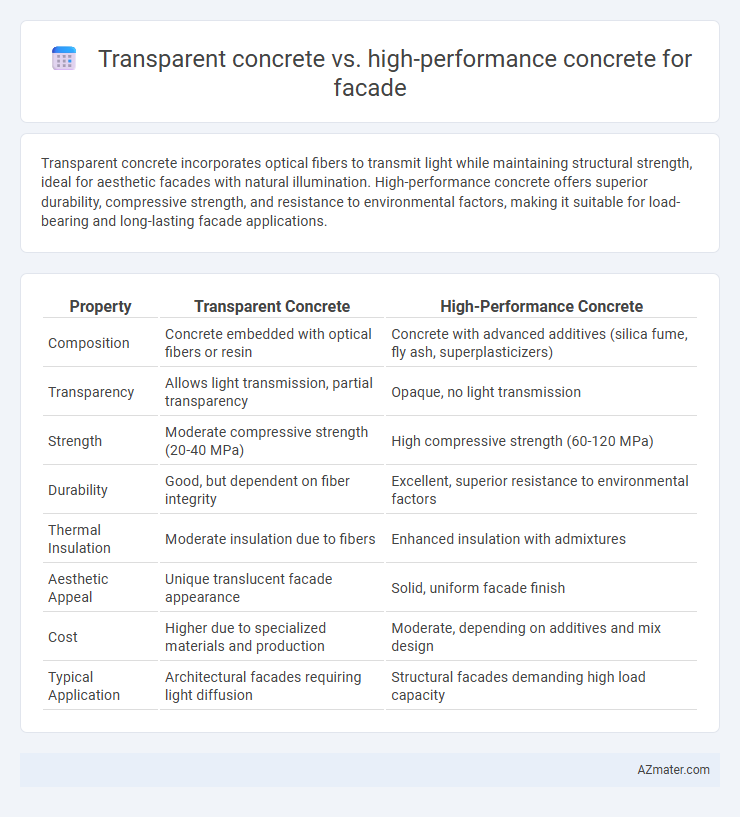Transparent concrete incorporates optical fibers to transmit light while maintaining structural strength, ideal for aesthetic facades with natural illumination. High-performance concrete offers superior durability, compressive strength, and resistance to environmental factors, making it suitable for load-bearing and long-lasting facade applications.
Table of Comparison
| Property | Transparent Concrete | High-Performance Concrete |
|---|---|---|
| Composition | Concrete embedded with optical fibers or resin | Concrete with advanced additives (silica fume, fly ash, superplasticizers) |
| Transparency | Allows light transmission, partial transparency | Opaque, no light transmission |
| Strength | Moderate compressive strength (20-40 MPa) | High compressive strength (60-120 MPa) |
| Durability | Good, but dependent on fiber integrity | Excellent, superior resistance to environmental factors |
| Thermal Insulation | Moderate insulation due to fibers | Enhanced insulation with admixtures |
| Aesthetic Appeal | Unique translucent facade appearance | Solid, uniform facade finish |
| Cost | Higher due to specialized materials and production | Moderate, depending on additives and mix design |
| Typical Application | Architectural facades requiring light diffusion | Structural facades demanding high load capacity |
Introduction to Modern Concrete Facade Technologies
Transparent concrete integrates optical fibers to allow natural light transmission, enhancing aesthetic appeal and energy efficiency in facade applications. High-performance concrete (HPC) offers superior strength, durability, and resistance to environmental factors, making it ideal for structurally demanding facade systems. Both technologies represent advancements in modern concrete facade design, balancing functionality with innovative architectural expression.
What is Transparent Concrete?
Transparent concrete is a composite building material that incorporates optical fibers or light-transmitting elements embedded within a concrete matrix, allowing natural light to pass through while maintaining structural integrity. Unlike high-performance concrete, which is engineered for enhanced strength, durability, and resistance to environmental factors, transparent concrete prioritizes aesthetic appeal and daylight transmission for facade applications. This innovative material enables architects to create visually striking facades that reduce the need for artificial lighting and improve energy efficiency.
What is High-Performance Concrete?
High-performance concrete (HPC) is a specialized blend designed to provide superior strength, durability, and workability compared to conventional concrete. It incorporates advanced admixtures, supplementary cementitious materials such as silica fume or fly ash, and optimized aggregate gradation to achieve enhanced mechanical and durability properties. HPC is widely used in facade applications for its resistance to environmental stressors, improved aesthetic finishes, and ability to support complex architectural designs.
Key Material Properties Compared
Transparent concrete integrates optical fibers within the cement matrix, enabling light transmission while maintaining structural integrity, with tensile strengths typically around 30 MPa and high translucency rates up to 20%. High-performance concrete (HPC) offers superior compressive strengths exceeding 100 MPa, enhanced durability, and lower permeability, making it ideal for load-bearing facade applications but lacks light-transmitting capabilities. The choice depends on balancing transparency and aesthetic appeal against mechanical strength and durability requirements for facade design.
Aesthetic Advantages and Design Flexibility
Transparent concrete offers unique aesthetic advantages by allowing natural light diffusion while maintaining structural integrity, creating visually striking facades with dynamic light effects. High-performance concrete provides exceptional design flexibility through its superior strength and durability, enabling slender, intricate facade elements and varied textures that enhance architectural creativity. Combining both materials can elevate facade design by balancing translucency with structural precision and enduring performance.
Energy Efficiency and Light Transmission
Transparent concrete enhances energy efficiency in facades by allowing natural light transmission, reducing reliance on artificial lighting and contributing to passive solar heating. High-performance concrete offers superior thermal insulation and durability, optimizing energy conservation by minimizing heat transfer through the building envelope. Combining both materials can create facades that balance light transmission with thermal efficiency, improving overall building energy performance.
Structural Strength and Durability
Transparent concrete for facades incorporates optical fibers or light-transmitting elements, providing moderate structural strength primarily suited for decorative applications rather than load-bearing. High-performance concrete (HPC) offers superior structural strength and enhanced durability due to optimized mix designs, additives like silica fume, and improved curing methods, making it ideal for demanding facade systems exposed to harsh environmental conditions. While transparent concrete excels in aesthetic innovation, high-performance concrete ensures long-term resilience and structural integrity for facade engineering.
Installation and Maintenance Considerations
Transparent concrete offers lightweight installation benefits due to its embedded optical fibers, which require delicate alignment and specialized handling, whereas high-performance concrete demands robust formwork and extended curing times for optimal strength. Maintenance of transparent concrete involves routine cleaning to preserve light transmission and inspecting fibers for damage, while high-performance concrete requires periodic checks for surface cracks and sealant integrity to prevent weathering. Choosing between them depends on balancing the complexity of installation and the long-term durability needs of the facade project.
Cost Implications and Project Scalability
Transparent concrete, incorporating optical fibers or resin, offers unique aesthetic appeal and natural light transmission but involves higher material and fabrication costs compared to high-performance concrete (HPC). HPC provides superior strength, durability, and workability at a generally lower price point, making it more cost-effective for large-scale facade projects. Project scalability favors HPC due to more standardized production and easier integration with existing construction techniques, whereas transparent concrete requires specialized handling that can limit volume and increase overall expenses.
Conclusion: Selecting the Ideal Facade Material
Transparent concrete offers unique aesthetic and lighting advantages for facades through embedded optical fibers, enhancing natural illumination while maintaining structural integrity. High-performance concrete (HPC) provides superior durability, strength, and resistance to environmental stressors, making it ideal for long-lasting, low-maintenance facades. Selecting the ideal facade material depends on balancing design goals with functional requirements, where transparent concrete suits innovative architectural visuals and HPC supports robust, sustainable building envelopes.

Infographic: Transparent concrete vs High-performance concrete for Facade
 azmater.com
azmater.com